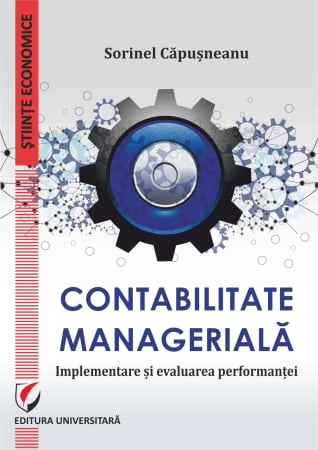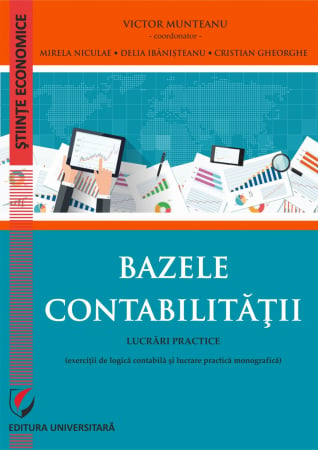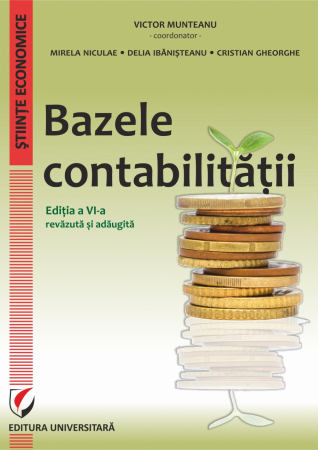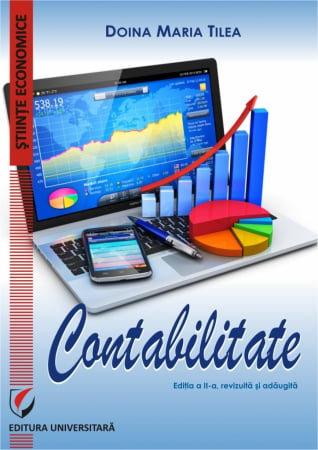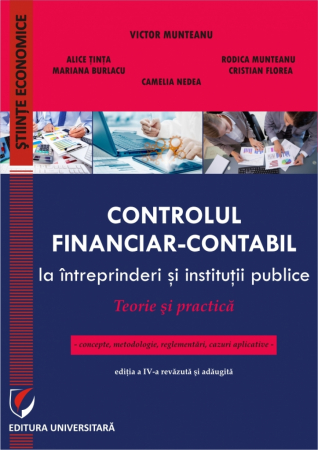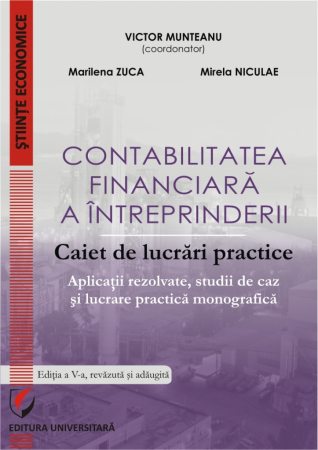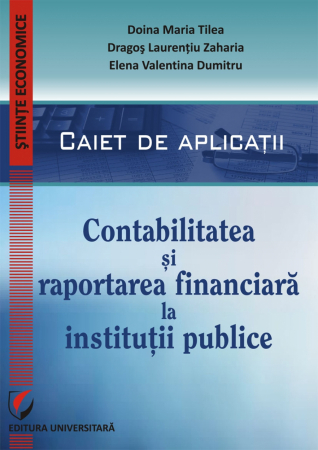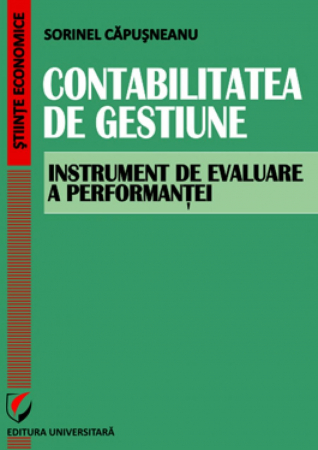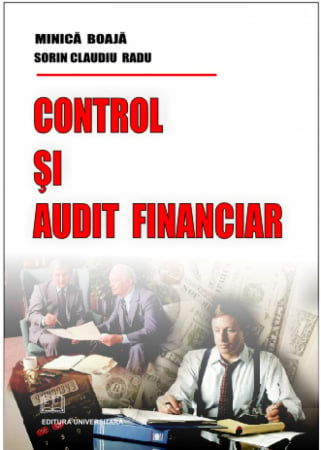Manuscript proposals: [email protected] / 0745 204 115 //// Tracking orders Individuals / Sales: 0745 200 357 / Orders Legal entities: 0721 722 783
Publisher: Editura Universitară
Author: Victor Munteanu - Coordonator
ISBN: 978-606-28-0654-5
DOI: 10.5682/9786062806545
Publisher year: 2017
Edition: V
Pages: 346
Product Code:
9786062806545
Do you need help?
0745 200 357
- Description
- Download (1)
- Authors
- Content
- More details
- Reviews (0)
The fund of ideas circumscribed in the content of the paper is addressed, first of all, to all students in economic, state and private education, but also to those from other higher education institutions, who through their study programs also focuses on accounting. It is intended, secondly, and can be consulted by business managers, lawyers, accounting practitioners - certified accountants, chartered accountants, financial auditors, financial analysts - who want to deepen the informational value of accounting.
His methodological-didactic approach aims to offer, especially to students, the most efficient ways to understand and deepen all accounting problems, to form a logical, independent accounting thinking, as well as the skills necessary for "production" and use of accounting information. in the management activity of the patrimonial entities.
The accounting reform process in our country has encouraged us to introduce elements of International Financial Reporting Standards (IFRS) and to take a flexible approach to the use of the chart of accounts.
His methodological-didactic approach aims to offer, especially to students, the most efficient ways to understand and deepen all accounting problems, to form a logical, independent accounting thinking, as well as the skills necessary for "production" and use of accounting information. in the management activity of the patrimonial entities.
The accounting reform process in our country has encouraged us to introduce elements of International Financial Reporting Standards (IFRS) and to take a flexible approach to the use of the chart of accounts.
-
BAZELE CONTABILITATII
Download
VICTOR MUNTEANU - Coordonator
ALICE TINTA
MIRELA NICULAE
RODICA MUNTEANU
MARIANA BURLACU
ALICE TINTA
MIRELA NICULAE
RODICA MUNTEANU
MARIANA BURLACU
FOREWORD / 9
CHAPTER 1: ACCOUNTING - HISTORICAL EVOLUTION, DEFINITION / 15
1.1. A brief historical look at accounting / 15
1.2. Stages of accounting formation and development / 16
1.3. The place of accounting in the set of scientific knowledge / 17
1.4. Exercises and problems / 21
CHAPTER 2: ACCOUNTING - COMPONENT OF THE FINANCIAL-ACCOUNTING INFORMATION SYSTEM / 22
2.1. The place of accounting in the system of economic sciences / 22
2.2. Economic evidence - component of the financial accounting information system / 26
2.3. Accounting attributions and functions. Accounting systems / 28
2.4. Users of accounting information / 33
2.5. Accounting regulation in Romania / 36
2.6. Exercises and problems / 38
CHAPTER 3: PURPOSE AND METHOD OF ACCOUNTING / 40
3.1. Theories and conceptions regarding the definition and object of accounting / 40
3.2. The object of study of accounting / 43
3.2.l. Assets, liabilities and equity - object of study of accounting / 43
3.2.2. Scope of the object of accounting / 49
3.2.3. From the object of accounting to the objective of accounting / 50
3.3. Economic processes and legal relations - elements of the accounting object / 52
3.3.l. Economic processes / 52
3.3.2. Legal relations / 53
3.4. Accounting method and principles / 54
3.4.1. The notion and concept of method / 54
3.4.2. Principles of the accounting method / 57
3.4.2.1. Principles specific to the accounting method / 57
3.4.2.2. "Generally accepted" principles for the preparation and presentation of financial statements / 69
3.4.3. Processes of the accounting method / 70
3.5. Financial year - accounting. Accounting information system / 75
3.6. Exercises and problems / 77
CHAPTER 4: BASIC MODELS REGARDING THE STATEMENT OF EQUITY (ASSETS, LIABILITIES AND OWN CAPITALS) AND OF THE RESULTS OBTAINED / 80
4.1. Balance sheet - model regarding the statement of assets, liabilities and equity (statement of financial position) / 80
4.1.1. Balance sheet: definition, role, functions, types, forms / 80
4.1.2. Balance sheet - procedure of the double representation of the patrimony / 85
4.1.3. Balance sheet structures regarding the entity 's patrimony / 88
4.1.3.1. Balance sheet assets / 89
4.1.3.2. Balance sheet liability / 97
4.1.4. Types of changes regarding the entity 's assets and liabilities / 101
4.2. Asset modeling through the income statement (profit and loss account) - financial performance statement / 116
4.3. Exercises and problems / 124
CHAPTER 5: THEORY AND MODEL REGARDING THE ACCOUNT. ACCOUNTING MECHANISM: ANALYSIS, RECORDING AND CONTROL OF TRANSACTIONS (OPERATIONS) IN ACCOUNTS / 127
5.1. The notion, necessity and content of the account / 127
5.2. Account structure and form / 131
5.3. Rules of operation of accounts / 136
5.4. Double registration and correspondence of accounts / 140
5.5. Accounting analysis of economic transactions and their reflection in accounting. Accounting formula and article / 144
5.6. The system of accounts and their classification / 151
5.7. Accounting normalization. General chart of accounts / 155
5.8. Checking balance - specific procedure of the accounting method / 174
5.8.1. The notion, importance and functions of the checking balance / 174
5.8.2. The principle of balance of accounts / 175
5.8.3. Advantages of the balance of accounts / 175
5.8.4. Classification of the balance of accounts / 176
5.8.5. Preparation of the balance of accounts / 178
5.9. Exercises and problems / 179
CHAPTER 6: ACCOUNTING DOCUMENTS / 181
6.1. The notion and importance of accounting documents / 181
6.2. Delimitations regarding the accounting documents / 182
6.2.1. Documents or supporting documents / 183
6.2.2. Accounting registers / 187
6.2.3. Summary accounting documents or financial statements / 192
CHAPTER 7: EVALUATION AND RECOGNITION OF ITEMS IN FINANCIAL STATEMENTS / 205
7.1. Accounting quantification / 205
7.2. Accounting valuation / 206
7.2.1. Basics of evaluation in accounting / 206
7.2.2. Valuation rules as a reference system in the formulation of accounting policies / 209
7.3. Exercises and problems / 213
CHAPTER 8: ROLE, ECONOMIC CONTENT, ANALYSIS AND FUNCTIONING OF CAPITAL ACCOUNTS / 214
8.1. Delimitations and structures regarding capitals / 214
8.2. Accounts on equity of the entity / 215
8.2.1. Accounts and transactions regarding the share capital / 215
8.2.2. Other equity accounts / 221
8.2.3. Accounts and transactions regarding long - term debts / 223
8.3. Exercises and problems / 225
CHAPTER 9: ROLE, ECONOMIC CONTENT, ANALYSIS AND FUNCTIONING OF FIXED ASSETS ACCOUNTS / 229
9.1. Boundaries. Types of fixed assets / 229
9.2. Evaluation of tangible and intangible assets / 230
9.3. Depreciation: meanings, duration of economic use, calculation methods / 232
9.4. Documents specific to fixed assets / 235
9.5. Accounts and transactions regarding fixed assets / 237
9.6. Exercises and problems / 242
CHAPTER 10: ROLE, ECONOMIC CONTENT, ANALYSIS DATE AND FUNCTIONING OF STOCK ACCOUNTS / 244
10.1. Delimitations and stock valuation / 244
10.2. Accounts and transactions regarding stocks / 248
10.3. Exercises and problems / 257
CHAPTER 11: ROLE, ECONOMIC CONTENT, ANALYSIS AND FUNCTIONING OF THIRD PARTY ACCOUNTS / 259
11.1. Defining and grouping short-term receivables and payables / 259
11.2. Accounts and transactions regarding trade receivables and payables / 260
11.3. Accounts and transactions regarding receivables and salary debts / 264
11.4. Accounts and transactions regarding receivables and social debts / 267
11.5. Accounts and transactions regarding receivables and fiscal debts / 269
11.6. Accounts and transactions regarding miscellaneous receivables and payables / 273
11.7. Exercises and problems / 275
CHAPTER 12: ROLE, ECONOMIC CONTENT, ANALYSIS AND FUNCTIONING OF TREASURY ACCOUNTS / 276
12.1. Delimitations regarding the entity 's treasury / 276
12.2. Accounts and transactions regarding the company's treasury / 276
12.3. Cash flow statement / 282
12.4. Exercises and problems / 287
CHAPTER 13: ROLE, ECONOMIC CONTENT, ANALYSIS AND FUNCTIONING OF EXPENDITURE, INCOME AND RESULTS ACCOUNTS / 288
13.1. Delimitations and structures / 288
13.2. Accounts on expenses and income / 291
13.3. Accounting instrumentation of transactions regarding expenses and revenues / 292
13.4. Exercises and problems / 311
CHAPTER 14: COMPLETION OF THE ACCOUNTING CYCLE / 313
14.1. Presentation of the stages of the accounting cycle / 313
14.2. Monographic example regarding the realization of the accounting cycle / 313
BIBLIOGRAPHY / 345
CHAPTER 1: ACCOUNTING - HISTORICAL EVOLUTION, DEFINITION / 15
1.1. A brief historical look at accounting / 15
1.2. Stages of accounting formation and development / 16
1.3. The place of accounting in the set of scientific knowledge / 17
1.4. Exercises and problems / 21
CHAPTER 2: ACCOUNTING - COMPONENT OF THE FINANCIAL-ACCOUNTING INFORMATION SYSTEM / 22
2.1. The place of accounting in the system of economic sciences / 22
2.2. Economic evidence - component of the financial accounting information system / 26
2.3. Accounting attributions and functions. Accounting systems / 28
2.4. Users of accounting information / 33
2.5. Accounting regulation in Romania / 36
2.6. Exercises and problems / 38
CHAPTER 3: PURPOSE AND METHOD OF ACCOUNTING / 40
3.1. Theories and conceptions regarding the definition and object of accounting / 40
3.2. The object of study of accounting / 43
3.2.l. Assets, liabilities and equity - object of study of accounting / 43
3.2.2. Scope of the object of accounting / 49
3.2.3. From the object of accounting to the objective of accounting / 50
3.3. Economic processes and legal relations - elements of the accounting object / 52
3.3.l. Economic processes / 52
3.3.2. Legal relations / 53
3.4. Accounting method and principles / 54
3.4.1. The notion and concept of method / 54
3.4.2. Principles of the accounting method / 57
3.4.2.1. Principles specific to the accounting method / 57
3.4.2.2. "Generally accepted" principles for the preparation and presentation of financial statements / 69
3.4.3. Processes of the accounting method / 70
3.5. Financial year - accounting. Accounting information system / 75
3.6. Exercises and problems / 77
CHAPTER 4: BASIC MODELS REGARDING THE STATEMENT OF EQUITY (ASSETS, LIABILITIES AND OWN CAPITALS) AND OF THE RESULTS OBTAINED / 80
4.1. Balance sheet - model regarding the statement of assets, liabilities and equity (statement of financial position) / 80
4.1.1. Balance sheet: definition, role, functions, types, forms / 80
4.1.2. Balance sheet - procedure of the double representation of the patrimony / 85
4.1.3. Balance sheet structures regarding the entity 's patrimony / 88
4.1.3.1. Balance sheet assets / 89
4.1.3.2. Balance sheet liability / 97
4.1.4. Types of changes regarding the entity 's assets and liabilities / 101
4.2. Asset modeling through the income statement (profit and loss account) - financial performance statement / 116
4.3. Exercises and problems / 124
CHAPTER 5: THEORY AND MODEL REGARDING THE ACCOUNT. ACCOUNTING MECHANISM: ANALYSIS, RECORDING AND CONTROL OF TRANSACTIONS (OPERATIONS) IN ACCOUNTS / 127
5.1. The notion, necessity and content of the account / 127
5.2. Account structure and form / 131
5.3. Rules of operation of accounts / 136
5.4. Double registration and correspondence of accounts / 140
5.5. Accounting analysis of economic transactions and their reflection in accounting. Accounting formula and article / 144
5.6. The system of accounts and their classification / 151
5.7. Accounting normalization. General chart of accounts / 155
5.8. Checking balance - specific procedure of the accounting method / 174
5.8.1. The notion, importance and functions of the checking balance / 174
5.8.2. The principle of balance of accounts / 175
5.8.3. Advantages of the balance of accounts / 175
5.8.4. Classification of the balance of accounts / 176
5.8.5. Preparation of the balance of accounts / 178
5.9. Exercises and problems / 179
CHAPTER 6: ACCOUNTING DOCUMENTS / 181
6.1. The notion and importance of accounting documents / 181
6.2. Delimitations regarding the accounting documents / 182
6.2.1. Documents or supporting documents / 183
6.2.2. Accounting registers / 187
6.2.3. Summary accounting documents or financial statements / 192
CHAPTER 7: EVALUATION AND RECOGNITION OF ITEMS IN FINANCIAL STATEMENTS / 205
7.1. Accounting quantification / 205
7.2. Accounting valuation / 206
7.2.1. Basics of evaluation in accounting / 206
7.2.2. Valuation rules as a reference system in the formulation of accounting policies / 209
7.3. Exercises and problems / 213
CHAPTER 8: ROLE, ECONOMIC CONTENT, ANALYSIS AND FUNCTIONING OF CAPITAL ACCOUNTS / 214
8.1. Delimitations and structures regarding capitals / 214
8.2. Accounts on equity of the entity / 215
8.2.1. Accounts and transactions regarding the share capital / 215
8.2.2. Other equity accounts / 221
8.2.3. Accounts and transactions regarding long - term debts / 223
8.3. Exercises and problems / 225
CHAPTER 9: ROLE, ECONOMIC CONTENT, ANALYSIS AND FUNCTIONING OF FIXED ASSETS ACCOUNTS / 229
9.1. Boundaries. Types of fixed assets / 229
9.2. Evaluation of tangible and intangible assets / 230
9.3. Depreciation: meanings, duration of economic use, calculation methods / 232
9.4. Documents specific to fixed assets / 235
9.5. Accounts and transactions regarding fixed assets / 237
9.6. Exercises and problems / 242
CHAPTER 10: ROLE, ECONOMIC CONTENT, ANALYSIS DATE AND FUNCTIONING OF STOCK ACCOUNTS / 244
10.1. Delimitations and stock valuation / 244
10.2. Accounts and transactions regarding stocks / 248
10.3. Exercises and problems / 257
CHAPTER 11: ROLE, ECONOMIC CONTENT, ANALYSIS AND FUNCTIONING OF THIRD PARTY ACCOUNTS / 259
11.1. Defining and grouping short-term receivables and payables / 259
11.2. Accounts and transactions regarding trade receivables and payables / 260
11.3. Accounts and transactions regarding receivables and salary debts / 264
11.4. Accounts and transactions regarding receivables and social debts / 267
11.5. Accounts and transactions regarding receivables and fiscal debts / 269
11.6. Accounts and transactions regarding miscellaneous receivables and payables / 273
11.7. Exercises and problems / 275
CHAPTER 12: ROLE, ECONOMIC CONTENT, ANALYSIS AND FUNCTIONING OF TREASURY ACCOUNTS / 276
12.1. Delimitations regarding the entity 's treasury / 276
12.2. Accounts and transactions regarding the company's treasury / 276
12.3. Cash flow statement / 282
12.4. Exercises and problems / 287
CHAPTER 13: ROLE, ECONOMIC CONTENT, ANALYSIS AND FUNCTIONING OF EXPENDITURE, INCOME AND RESULTS ACCOUNTS / 288
13.1. Delimitations and structures / 288
13.2. Accounts on expenses and income / 291
13.3. Accounting instrumentation of transactions regarding expenses and revenues / 292
13.4. Exercises and problems / 311
CHAPTER 14: COMPLETION OF THE ACCOUNTING CYCLE / 313
14.1. Presentation of the stages of the accounting cycle / 313
14.2. Monographic example regarding the realization of the accounting cycle / 313
BIBLIOGRAPHY / 345
Accounting is a science and an important field of social practice.
Although very old, as a practical activity, accounting begins to take shape as a science with the appearance of the first book of accounts, in 1494, in Venice, author Luca Paciolo.
A synthetic and particularly expressive characterization regarding the functional valences of accounting left us, almost 80 years ago, the well-known scientist J.Fr. Schar, noting a motto in his work "Buchhaltung und Bilanz": "Accounting is the impartial judge of the past, the necessary guide of the present and the impartial adviser of the future, in every enterprise."
The study of accounting, as a science, also involves the study on the basis of documents of its origin and stages of evolution, from the first accounting notes to the current accounting. Thus, studying its past, it is found that in all historical epochs the need for accounting was felt to highlight, systematize, control, analyze and interpret phenomena related to the economic activity of human society, becoming indispensable for the enterprise as a patrimony owner.
Appreciations in this regard were made not only by specialists in the field, but also by people of different interests who managed to understand the science of accounting. Thus, Goethe, a great poet and thinker, appreciated in one of his works: "it (accounting) is one of the most sublime creations of human genius" being a mirror of the past and a guide of the future ".
Sombart Weiner, researching the role of accounting for the progress of mankind, stressed that it perfects the rules of management of a company because: "order and clarity in business increase the taste to save, to win" it was born from the same thinking with the systems of Galiuleu or Newton, with the theories of modern physics and chemistry… through it the capitalist economic system was able to realize its idea of gain and economy or economic rationalism ”.
Today, through the computerization of accounting works, the accounting technique has reached, in some countries, a high level of improvement.
"The accounting technique goes beyond its role established for centuries, which was to produce documents to close a management period, with which it has been identified for a long time. It has now become a wide-ranging technique for collecting and processing information, which has managed to detach itself from the simple contemplation of the past and which strives, due to scientific methods, to include the future evolution of economic activity.
The dynamic character of the production and commercial system in the enterprise imprints the same feature and the accounting system that reflects it. In this analogy, accounting is conceived as a global system of an enterprise, which enters into relations with the environment, regarding external information that it transmits to management to intervene and make decisions necessary to regulate its activity. Thus, accounting becomes the means of operative, dynamic information on the development of economic processes in the enterprise and, at the same time, the tool of analysis, coordination and control of economic and financial activity to know the economic pulse, in order to make the best management decisions.
The risks to which the enterprise is subjected in the conditions of the market economy make the accounting information indispensable. It can be appreciated that, today, accounting is for the enterprise what air and water are for life. Accounting knowledge must be possessed not only by the organizer and manager of the entity, but also by those who manage and are responsible for its assets.
Accounting is an informational discipline. It studies the effects of economic transactions and other events on the economic and financial situation, as well as on the performance of an enterprise.
This statement is also supported by historical arguments. For example, in ancient Egypt, accounting was considered so necessary that it was taught in all schools, and accountants could become priests, generals, governors.
Egyptologist Champolion points out that “all state officials were part of the accountants' corporation. The royal accountants were in charge of the entire administration ", and for the Greeks, according to the Athenian orator Eschine" a man can receive the crown only after he has accounted for the entrusted administration ".
It is worth emphasizing the importance that accounting has today for knowing the situation and leading the economic-financial activity, as well as the place that it must occupy in the training of specialists in the economic and legal field. Why? Because, as one parent of Romanian accounting said, “accounting facts, ie operations that are recorded by accounting, are of an economic and legal nature. What is an accountant the incorporation of a company than the accounting of a succession of legal facts? ” (Spiridon Iacobescu, 1923).
Finally, accounting has by its nature the quality of being a fundamental and applied science, with sides of theory and practice, of science and technique. It possesses, at the same time, two peculiarities characteristic of any science: of being permanent and universal. It is permanent in the sense that it is based on a series of its own legitimacies that have always guided it and that will remain valid as long as there are the conditions that generated it - respectively, the production and exchange of goods in human society. It is universal in that it has emerged and is governed by the same laws and principles everywhere, wherever it is used, in any social order and in any type of patrimonial unit.
Discussed in terms of the mentioned steps, the book "Basics of Accounting" acquires a special significance for all those who want to access the safe of accounting reasoning. It is the discipline of introduction in the scientific empire of accounting through which, gradually and methodically, one gets acquainted with the fundamental theoretical elements of its object and method of research, with the principles, procedures and specific means designed and used to obtain, capitalize and preserve information. on the financial position, financial performance and cash flows of an enterprise.
The book deals with this issue, trying to balance between what has accumulated and preserved accounting science and practice worldwide and nationally and the new modern accounting trends. Thus, the scientific and logical premises of accounting are approached by combining the classical theoretical-fundamental principles with the modern principles (conventions) of organization and management of accounting, accepted by standards by the world and European community.
Two of the basic procedures of the accounting method (Balance Sheet and Account), designed on the basis of theoretical principles - double representation and double registration - are the central elements of the paper through which we can understand the logic and mechanism in which accounting interprets, represents and essentializes in plan. computer science its object, its patrimony.
The fund of ideas circumscribed in the content of the paper is addressed, first of all, to all students in economic, state and private education, but also to those from other higher education institutions, who through their study programs also focus on accounting. It is intended, secondly, and can be consulted by business managers, lawyers, accounting practitioners - certified accountants, chartered accountants, financial auditors, financial analysts - who want to deepen the informational value of accounting.
His methodological-didactic approach aims to offer, especially to students, the most efficient ways to understand and deepen all accounting problems, to form a logical, independent accounting thinking, as well as the skills necessary for "production" and use of accounting information. in the management activity of the patrimonial entities.
The accounting reform process in our country has encouraged us to introduce elements of International Financial Reporting Standards (IFRS) and to take a flexible approach to the use of the chart of accounts.
When writing the paper we used a rich foreign legislation and literature, but especially local. We thank the Romanian normalizers for their efforts to create and then perfect a competitive accounting system.
We also appreciate the interest and professional competence of specialists in education, research and practice in the field of accounting for books, studies and our own points of view that have seen the light of day, so far, and that have been of real use to us in writing. works. We enjoyed the qualified support of the publishing house, the printing house, the editor and the word processors who took care of the operative preparation and the appearance in the best conditions of the work, for which we thank them.
Finally, we thank, a priori, our readers, pupils and students, teachers, specialists who will have the patience and interest to read and use this book.
We are aware that this paper can be improved, that it can be the subject of critical reflections, suggestions and proposals. Therefore, we will be grateful to all for the submitted recommendations that we are waiting for with due attention and that we will receive with pleasure and distinguished consideration and we will consider them in a possible new edition.
Bucharest, October 2017
The Authors
Although very old, as a practical activity, accounting begins to take shape as a science with the appearance of the first book of accounts, in 1494, in Venice, author Luca Paciolo.
A synthetic and particularly expressive characterization regarding the functional valences of accounting left us, almost 80 years ago, the well-known scientist J.Fr. Schar, noting a motto in his work "Buchhaltung und Bilanz": "Accounting is the impartial judge of the past, the necessary guide of the present and the impartial adviser of the future, in every enterprise."
The study of accounting, as a science, also involves the study on the basis of documents of its origin and stages of evolution, from the first accounting notes to the current accounting. Thus, studying its past, it is found that in all historical epochs the need for accounting was felt to highlight, systematize, control, analyze and interpret phenomena related to the economic activity of human society, becoming indispensable for the enterprise as a patrimony owner.
Appreciations in this regard were made not only by specialists in the field, but also by people of different interests who managed to understand the science of accounting. Thus, Goethe, a great poet and thinker, appreciated in one of his works: "it (accounting) is one of the most sublime creations of human genius" being a mirror of the past and a guide of the future ".
Sombart Weiner, researching the role of accounting for the progress of mankind, stressed that it perfects the rules of management of a company because: "order and clarity in business increase the taste to save, to win" it was born from the same thinking with the systems of Galiuleu or Newton, with the theories of modern physics and chemistry… through it the capitalist economic system was able to realize its idea of gain and economy or economic rationalism ”.
Today, through the computerization of accounting works, the accounting technique has reached, in some countries, a high level of improvement.
"The accounting technique goes beyond its role established for centuries, which was to produce documents to close a management period, with which it has been identified for a long time. It has now become a wide-ranging technique for collecting and processing information, which has managed to detach itself from the simple contemplation of the past and which strives, due to scientific methods, to include the future evolution of economic activity.
The dynamic character of the production and commercial system in the enterprise imprints the same feature and the accounting system that reflects it. In this analogy, accounting is conceived as a global system of an enterprise, which enters into relations with the environment, regarding external information that it transmits to management to intervene and make decisions necessary to regulate its activity. Thus, accounting becomes the means of operative, dynamic information on the development of economic processes in the enterprise and, at the same time, the tool of analysis, coordination and control of economic and financial activity to know the economic pulse, in order to make the best management decisions.
The risks to which the enterprise is subjected in the conditions of the market economy make the accounting information indispensable. It can be appreciated that, today, accounting is for the enterprise what air and water are for life. Accounting knowledge must be possessed not only by the organizer and manager of the entity, but also by those who manage and are responsible for its assets.
Accounting is an informational discipline. It studies the effects of economic transactions and other events on the economic and financial situation, as well as on the performance of an enterprise.
This statement is also supported by historical arguments. For example, in ancient Egypt, accounting was considered so necessary that it was taught in all schools, and accountants could become priests, generals, governors.
Egyptologist Champolion points out that “all state officials were part of the accountants' corporation. The royal accountants were in charge of the entire administration ", and for the Greeks, according to the Athenian orator Eschine" a man can receive the crown only after he has accounted for the entrusted administration ".
It is worth emphasizing the importance that accounting has today for knowing the situation and leading the economic-financial activity, as well as the place that it must occupy in the training of specialists in the economic and legal field. Why? Because, as one parent of Romanian accounting said, “accounting facts, ie operations that are recorded by accounting, are of an economic and legal nature. What is an accountant the incorporation of a company than the accounting of a succession of legal facts? ” (Spiridon Iacobescu, 1923).
Finally, accounting has by its nature the quality of being a fundamental and applied science, with sides of theory and practice, of science and technique. It possesses, at the same time, two peculiarities characteristic of any science: of being permanent and universal. It is permanent in the sense that it is based on a series of its own legitimacies that have always guided it and that will remain valid as long as there are the conditions that generated it - respectively, the production and exchange of goods in human society. It is universal in that it has emerged and is governed by the same laws and principles everywhere, wherever it is used, in any social order and in any type of patrimonial unit.
Discussed in terms of the mentioned steps, the book "Basics of Accounting" acquires a special significance for all those who want to access the safe of accounting reasoning. It is the discipline of introduction in the scientific empire of accounting through which, gradually and methodically, one gets acquainted with the fundamental theoretical elements of its object and method of research, with the principles, procedures and specific means designed and used to obtain, capitalize and preserve information. on the financial position, financial performance and cash flows of an enterprise.
The book deals with this issue, trying to balance between what has accumulated and preserved accounting science and practice worldwide and nationally and the new modern accounting trends. Thus, the scientific and logical premises of accounting are approached by combining the classical theoretical-fundamental principles with the modern principles (conventions) of organization and management of accounting, accepted by standards by the world and European community.
Two of the basic procedures of the accounting method (Balance Sheet and Account), designed on the basis of theoretical principles - double representation and double registration - are the central elements of the paper through which we can understand the logic and mechanism in which accounting interprets, represents and essentializes in plan. computer science its object, its patrimony.
The fund of ideas circumscribed in the content of the paper is addressed, first of all, to all students in economic, state and private education, but also to those from other higher education institutions, who through their study programs also focus on accounting. It is intended, secondly, and can be consulted by business managers, lawyers, accounting practitioners - certified accountants, chartered accountants, financial auditors, financial analysts - who want to deepen the informational value of accounting.
His methodological-didactic approach aims to offer, especially to students, the most efficient ways to understand and deepen all accounting problems, to form a logical, independent accounting thinking, as well as the skills necessary for "production" and use of accounting information. in the management activity of the patrimonial entities.
The accounting reform process in our country has encouraged us to introduce elements of International Financial Reporting Standards (IFRS) and to take a flexible approach to the use of the chart of accounts.
When writing the paper we used a rich foreign legislation and literature, but especially local. We thank the Romanian normalizers for their efforts to create and then perfect a competitive accounting system.
We also appreciate the interest and professional competence of specialists in education, research and practice in the field of accounting for books, studies and our own points of view that have seen the light of day, so far, and that have been of real use to us in writing. works. We enjoyed the qualified support of the publishing house, the printing house, the editor and the word processors who took care of the operative preparation and the appearance in the best conditions of the work, for which we thank them.
Finally, we thank, a priori, our readers, pupils and students, teachers, specialists who will have the patience and interest to read and use this book.
We are aware that this paper can be improved, that it can be the subject of critical reflections, suggestions and proposals. Therefore, we will be grateful to all for the submitted recommendations that we are waiting for with due attention and that we will receive with pleasure and distinguished consideration and we will consider them in a possible new edition.
Bucharest, October 2017
The Authors
If you want to express your opinion about this product you can add a review.
write a review

6359.png)
![Accounting Basis - Victor Munteanu - Coordonator [1] Accounting Basis - Victor Munteanu - Coordonator [1]](https://gomagcdn.ro/domains/editurauniversitara.ro/files/product/large/bazele-contabilitatii-376-988909.jpg)
